
The new-vehicle inventory shortage resulting from the microchip crisis is challenging the finance and insurance process at U.S. dealerships, changing which products are selling and how best to navigate customers’ financial situations.
F&I product companies say dealership sales of service contracts and guaranteed asset protection products are rising, though products such as key fob protection and tire-and-wheel are falling by the wayside. Here’s what experts are seeing.
David Adcock, executive vice president of Binary Automotive Solutions:
“Now is a good time to make sure we’re paying attention to processes in the store. Things as simple as reordering the menu. There are some products doing better than others. With pre-owned-heavy inventory, maintenance becomes more important, even a paint protectant. We’re hearing that people are buying these cars with the intention of being a stopgap between now and the time the inventory comes back. Customers are asking how they can protect that car as much as possible so that when they trade it in, it continues to retain its value.”
John Tabar, vice president of training at the United Development Systems Inc. offices of Brown & Brown Dealer Services:
“It’s a seller’s market without any inventory, which is tough. If you’re going to trade a vehicle in, now’s the time to do it. But [if you’re buying, too,] now we get into a situation where loan-to-value is an issue. Unfortunately, where this really has the biggest effect is on your lower-end to middle buyer on inventory. Some of those [value] vehicles are getting harder and harder to come by, which really stresses out that buyer who’s on a strict budget. They’re trying to get as much on the loan as they can, but they’re being stretched out.”
Brian Crisorio, vice president at the United Development Systems Inc. offices of Brown & Brown Dealer Services:
“If used-car values decline even a little bit, it’s going to create some really hefty exposure for those GAP companies. Incentives change. The financing options and terms that are usually given by manufacturers to incentivize buyers are going to shift. I’m usually giving an incentive to try to move inventory. I don’t know that’s our incentive now when we don’t have as much in the pipeline as we did. What’s going to happen to those 0 percents and financing offers that the customers were able to enjoy? Those are going to start to shrink in the short term.”
Scot Eisenfelder, CEO of APCO Holdings, parent company of EasyCare and GWC Warranty brands:
“We are seeing higher attachment rates for service contracts. Some of this is due to more focus from dealerships, but I also think consumers are more open to protecting their investment. Many consumers have been through some trying times over the past 15 months. That uncertainty has surely impacted their interest in protecting themselves against a future unknown.
“The biggest negatives are some dealers are abandoning ancillary products — such as key and dent — that are often packaged as branded giveaways. While understandable, I think that is shortsighted. Your brand needs to be your brand in good times and bad. The biggest positive is that dealers are refocusing on F&I. There is a tremendous effort on rebuilding people and process.”
Edvie Castro, general counsel at Dealer Owned Warranty Co.:
“GAP absolutely remains a very important product, and with the price of the vehicles increasing, it’s probably more important for people now than ever. There’s also been a focus on similar financial protection products. We have a total-loss protection product, which is a variation on our theft protection product. We also have a value-protect product, which is focused on the diminished value resulting from car accidents, and a payment shield product … if someone loses their job. We have quite a few dealers who are offering those products to help people make payments. Consumers are looking for more than GAP at this point. And we as an industry have to be able to meet their needs.”

